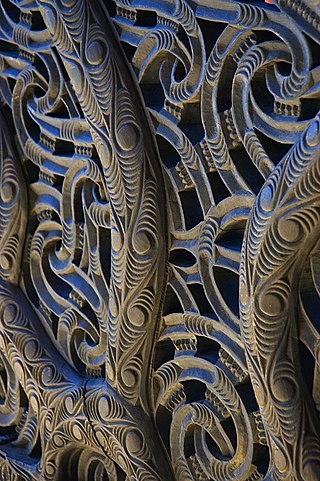Related Research Articles

In Māori mythology, Tāwhaki is a semi-supernatural being associated with lightning and thunder.
In Māori mythology Hinepiripiri occurs in some versions of the legend of Tāwhaki as Tāwhaki's wife and the mother of Wahieroa.
Atea is a deity in several Polynesian cultures, including the Marquesas and Tuamotu Islands, and New Zealand.
Whiro-te-tipua is the lord of darkness and embodiment of all evil in Māori mythology. He inhabits the underworld and is responsible for the ills of all people, a contrast to his brother and enemy Tāne.

In Hawaiian mythology, Laka is the name of two different popular heroes from Polynesian mythology..

In Māori mythology, Matuku-tangotango (Matuku) is an ogre who kills Wahieroa the son of Tāwhaki. In some versions, Matuku lives in a cave called Putawarenuku. Rātā, the son of Wahieroa, sets off to avenge his murdered father, and arrives at last at Matuku's village. He hears from Matuku's servant that at the new moon his master can be killed at the pool where he washes his face and hair. When the new moon has come, Rātā waits until the ogre comes out of his cave and is leaning over with his head in the pool. He grabs him by the hair and kills him. Rātā then sets off to rescue his father's bones from the Ponaturi. A South Island version names the islands where Matuku lives as Puorunuku and Puororangi and also states that Rātā nooses Matuku as he comes out of his lair to perform certain rituals.
In Māori mythology, Wahieroa is a son of Tāwhaki, and father of Rātā.
In the Polynesian narrative of the Tuamotus archipelago in the South Pacific, Puna is the king of Hiti-marama or of Vavaʻu, depending on the story.
In Tuamotu mythology, Vahieroa marries Matamata-taua or Tahiti-to'erau, and on the night of the birth of their son, the great Tuamotuan hero, Rata, the parents go fishing and are snatched away by the demon bird belonging to Puna, king of Hiti-marama, "an island north of Pitcairn and Elizabeth but long since swallowed in the sea."
In the Tuamotu Rata cycle, Tahiti-tokerau was a water-nymph whom Vahi-vero marries. She was abducted by Puna, king of the underworld and rescued by her husband. They then become parents of Rata.

Mahuika is a Māori fire deity. Generally, Mahuika is female and wife of the god Auahitūroa.
In Māori mythology, Matoka-rau-tāwhiri is a wife of Wahieroa, and mother of Rātā.

In Māori mythology, accounts vary somewhat as to the ancestry of Rātā. Usually he is a grandson of Tāwhaki and son of Wahieroa. Wahieroa is treacherously killed by Matuku-tangotango, an ogre. Rātā sets out to avenge the murder, travelling to the home of Matuku, where a servant of the ogre tells him that Matuku comes out to devour people each new moon, and that he can be killed at the pool where he washes his face and hair. Rātā waits till the ogre comes out and is leaning over with his head in the pool. He grabs him by the hair and kills him. Matuku's bones are used to make spears for hunting birds.
Rata, in Tahitian mythology, is said to have become king of Tahiti when his uncle, king Tumu-nui, and his father Vahieroa are swallowed by a great clam while they are on their way to Pitcairn. When he reaches adulthood, Rata plans to avenge his father. As in the Tuamotuan version, Rata identifies a tree to build his canoe, but it is protected by forest elves. After he captures them they build it for him in a single night. While en route for Pitcairn, Rata and his crew are sucked down into the same clam, but they use their spears to cut the monster open. They rescue the remains of Rata's father and uncle and bury them back in Tahiti. After recovering from their adventure, Rata sets out for further adventures. See also Aremata-Popoa and Aremata-Rorua.

Māori mythology and Māori traditions are two major categories into which the remote oral history of New Zealand's Māori may be divided. Māori myths concern fantastic tales relating to the origins of what was the observable world for the pre-European Māori, often involving gods and demigods. Māori tradition concerns more folkloric legends often involving historical or semi-historical forebears. Both categories merge in whakapapa to explain the overall origin of the Māori and their connections to the world which they lived in.
In Tuamotu mythology, Vahi-vero is the son of the demigod Kui and a goblin woman named Rima-roa.
Vahieroa may refer to:
In Tahitian mythology, Vahieroa is a son of Tafa'i and his wife Hina, and is born at his father's house in the Tapahi hills of Mahina in north Tahiti. He weds Maemae-a-rohi, sister of the ruling chief Tumu-nui.
Kui was a chthonic demigoddess and the wife of Tuputupuwhenua in Māori mythology. They supposedly live underground and when a new house is built, a tuft of grass is offered to them.
Rata is a Polynesian name, which is reflected in the Māori, Tahitian and Tuamotu mythology. Also an alternate spelling for Ratha an Arabic word or a name given. https://en.m.wikipedia.org/wiki/Ratha
References
- R.D. Craig, Dictionary of Polynesian Mythology (Greenwood Press: New York, 1989), 320–2.